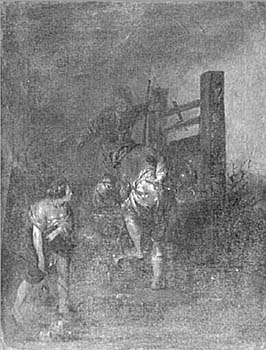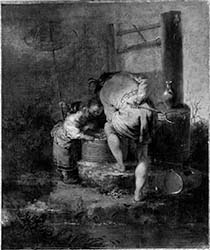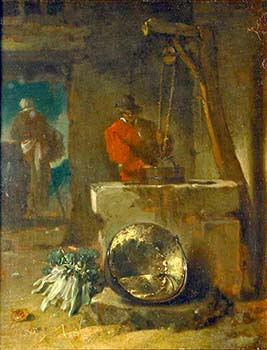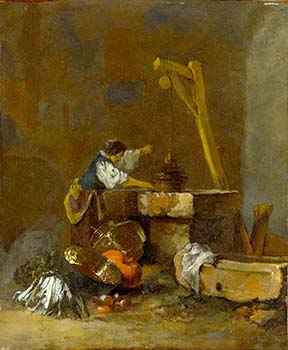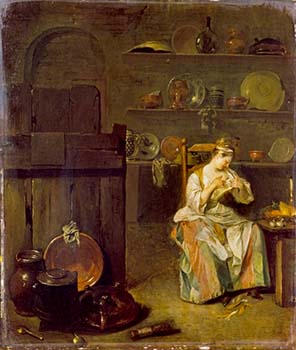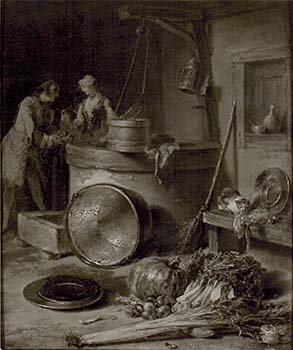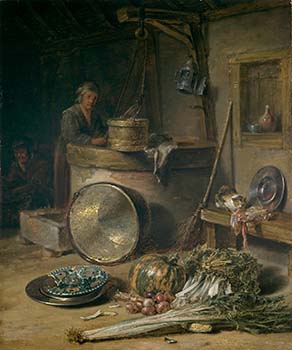
- Home Page
- Accepted
Paintings & Copies - Doubtful
Attributions - Doubtful Textual References
- Alternative
Titles - Collectors &
Museums - Bibliography
- Search Abecedario
- Watteau &
His Circle
L’Ecureuse de cuivre
Entered July 2021; revised September 2021
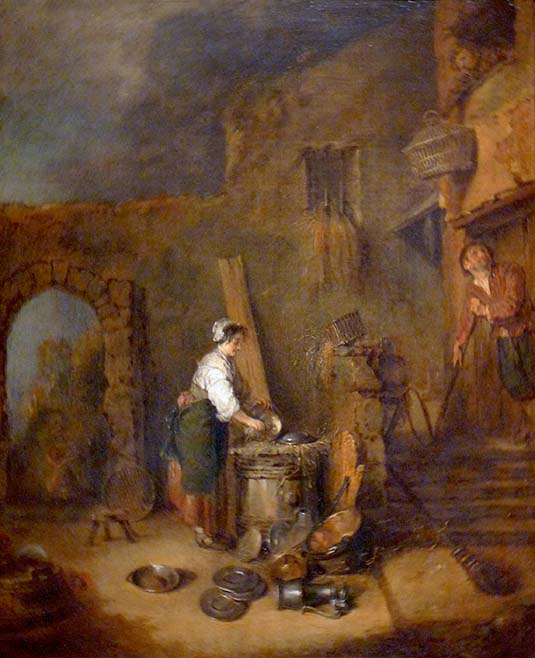
Strasbourg, Musée des beaux-arts, inv. 233
Oil on canvas
53 x 44 cm
ALTERNATIVE TITLES
Cleaning the Copper
The Cook
La Cuisinière
Donna che pilisce dei rami
L’Ecureuse de cuivres
L’Ecureuse de vaiselle
The Exterior of a Kitchen with Girl Scouring Pots
A Girl Scouring
Die Geschirrputzerin
Interior of a Kitchen
The Kitchen Maid
Die Köchin
Die Kupfer-Putzerin
Peasant Scene
Saucepan Cleaner
Woman Cleaning Copper
Woman Scouring a Pot
Woman Scouring Pots
PROVENANCE
London, collection of George Cooke (c. 1705–1768; Member of Parliament). His sale, London, Langford, March 3, 1769, lot 40: “REMBRANDT . . . A Girl sewing [sic for Scouring], by Watteau, in the Stile of.”
Twickenham, Strawberry Hill, collection of Horace Walpole (1717-1797). Listed in the catalogue he compiled of his collection: “Horace Walpole, A Description of the Villa of Mr. Horace Walpole, Youngest Son of Sir Robert Walpole, Earl of Orford (1774): “A girl scowering pots, a curious picture being painted by Watteau in the style of Rembrandt. It was in the collection of Mr. Cooke member for Middlesex.“
His sale, Strawberry Hill, May 18-25 April 1842, lot 82: “THE EXTERIOR OF A KITCHEN with Girl Scouring pots, a Boy hanging up a Bird Cage and Man in the Doorway . This curious picture is considered to be painted in the style of Rembrandt, rendering it a peculiar specimen of the master, it was originally in the collection of Mr. Cooke, Member for Middlesex.” Sold for £35.14 to John P. Beavan.London (?), collection of John P. Beavan.
Paris, with Edouard Warneck (1834-1924; art dealer).
Bought from Warneck by Wilhelm Bode for the Strasbourg museum in 1890.
EXHIBITIONS
Paris, Musée Carnavalet, Les Chefs d’oeuvre (1933), cat. 115.
San Francisco, Palace of the Legion of Honor, Rococo Masterpieces (1949), cat. 50 (Watteau, L’Ecureuse de cuivres [Woman Scouring Pots]).
Vienna, Oberes Belvedere, Kunst und Geist (1966), cat. 74 (Watteau, Die Köchlin, lent by the Musée de Strasbourg).
Brussels, Palais des beaux-arts, De Watteau à David (1975), cat. 96 (Watteau, L’Ecureuse de cuivres, lent by the Musée des beaux-arts, Strasbourg).
Washington, Paris and Berlin, Watteau 1684-1721 (1984), cat. P 7 (Watteau, The Woman Cleaning Copper [L’Ecureuse de cuivre], lent by the Musée des beaux-arts, Strasbourg).
Lille, Musée des beaux-arts, Au Temps de Watteau (1985) cat. 118 (Watteau, L’Ecureuse de cuivres aussi appelée La Cuisinière, lent by the Musée des beaux-arts, Strasbourg).
SELECT BIBLIOGRAPHY
Terey, “Die neue städtische Gemäldegalerie” (1893), 77.
Dehio, Verzeichnis der städtischen Gemälde-Sammlung (1899), cat. 368.
Girodie, “Les Musées de Strasbourg” (1907), 184.
Dehio, Verzeichnis des Kunstmuseums (1912), cat. 369.
Zimmermann, Watteau (1912), pl. 2.
Pilon, Watteau (1912), 50.
Gillet, L’Art flamand et la France (1918), 36.
Gillet, Un grand maître (1921), 25.
Nicolle, “Watteau dans les musées de province” (1921), 136.
Magnin, Un Cabinet d’amateur (1922), under cat. 302.
Haug, Peintures (1926), 12-13.
Dacier, Vuaflart, and Hérold, Jean de Jullienne et les graveurs (1921-29), 1: 174.
Réau, “Watteau” (1928), cat. 166.
Rey, Quelques satellites (1931), 178.
Fierens, “Au Musée Carnavalet” (1933), 60.
Haug, Catalogue des peintures anciennes (1938), 180.
Magnin, Un Cabinet d’amateur parisien (1938), 2: under cat. 302.
Barker, Antoine Watteau (1939), 29.
Puyvelde-Lasalle, Watteau et Rubens (1943), 13.
Florisoone, Le Dix-huitième siècle (1948), 39.
Adhémar, Watteau (1950), cat. 3.
Adhémar, “Watteau et ses amis” (1956), 20.
Mathey, Watteau, peintures réapparues (1959), 24, 66, cat. 7.
Gauthier, Watteau (1959), pl. 2.
Vergnet-Ruiz and Laclotte, Petits et grands musées (1962) 70, 256.
Chatelet and Thuillier, French Painting (1963), 162.
Ananoff, “Watteau face à tous ses imitateurs” (1966), 17.
Macchia and Montagni, L’opera completa di Watteau (1968), cat. 4.
Ferré, Watteau (1972), 3: cat. B 95.
Paris, Musée de la monnaie, Pèlerinage (1977), 1: 147.
Cailleux, “A Strange Monument” (1975), 249.
Eidelberg, "Watteau Paintings in England” (1975), 580-81.
Banks, Watteau and the North (1977), 118-27.
Roland Michel, Watteau (1980), cat. 3.
Roland Michel, Watteau (1984), 211.
Posner, Watteau (1984), 18.
Wine, Watteau (1991), 7, 9.
Hill, Walpole's Art Collection (1997), 43.
Starcky and Isnard, Dijon, Musée Magnin (2000), under cat. 490.
Temperini, Watteau (2002), 32, cat. 2.
Glorieux, “L’Angleterre et Watteau” (2006), 60, 72-73.
Glorieux, Watteau (2011), 53-55.
Marandet, “Le Faux Watteau” (2018).
RELATED DRAWINGS
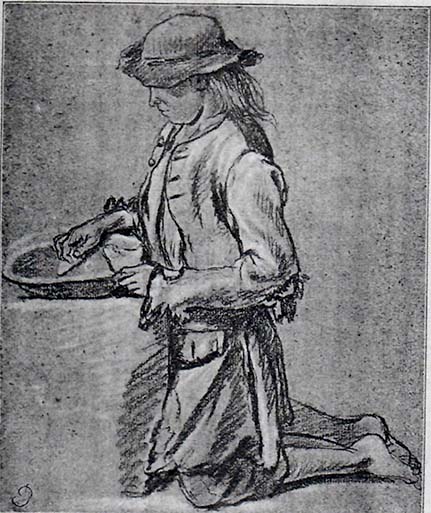
Anonymous French artist, Cuisinier bohémien, red, black, and white chalk, measurements unknown. Whereabouts unknown.
Ferré wrongly proposed that a copy after the Strasbourg painting was sold on June 12, 1899, from the collection of Gustave Déloye. Despite the vagueness of Ferré’s allusion, he appears to be referring to a trois-crayons drawing in that sale, lot 142, of a boy holding and scraping a bowl, which was titled Cuisinier bohémien. Regardless of its ascription to Watteau, it is definitely not by him and, moreover, it is unrelated to L’Ecureuse de cuivre. Rosenberg and Prat (cat. R 8) propose that it is close to Etienne Jeaurat.
REMARKS
When this painting emerged into the limelight in the last decade of the nineteenth century, bought by Wilhelm Bode for the Strasbourg museum, it was especially championed by German critics. A certain degree of political bias was reflected in Bode’s choice of this decidedly Northern subject. He had been brought from Berlin to create a museum for Strasbourg, which was now under German control, France having been defeated in the Franco-Prussian War. Bode could have chosen a fête galante to represent Watteau’s art, but he instead purchased a work not especially representative of French traditions.
After World War I, with Alsace-Lorraine restored to France, French critics turned their attention to this picture and many met it with skepticism. After all, its humble, rustic subject was exceptional in Watteau’s oeuvre, and the composition was not recorded in Jullienne’s Oeuvre gravé. The picture had no provenance, and no history of having been sold in the eighteenth or nineteenth centuries under Watteau’s name. When Bode bought the painting, the attribution was justified on the basis that Watteau, having been born in the Hainault, would have been schooled in the type of Netherlandish art evident here.
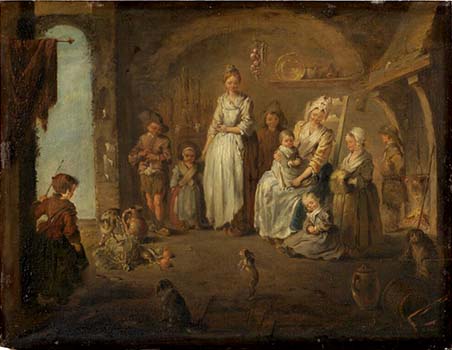
Jerome François Chantereau, Peasant Interior, oil on panel, 33 x 42 cm. Stockholm, Nationalmuseum.
A turning point in the painting’s critical history came in the late 1920s when Dacier, Vuaflart, and Hérold, supported by their colleague Jules Strauss, suggested that it was executed by Jérôme François Chantereau (c. 1710-1757), a relatively obscure painter active in the second quarter of the eighteenth century. Influenced by Watteau and emphasizing scenes of peasant life, Chantereau was a natural alternative candidate. In the mid-twentieth century it became almost mandatory to intone the Frenchman’s name, even when the author accepted the attribution to Watteau. Rey accepted the attribution to Chantereau, while Florisoone hesitated between Watteau and Chantereau.
The situation changed dramatically in 1975 when Eidelberg discovered the early provenance of the painting in English collections, namely that of George Cooke (prior to 1769), and then Horace Walpole, whose collection was not sold until 1842. This explains how the painting was overlooked for a century and a half. It also helps reaffirm the attribution to Watteau, to whom the painting was ascribed throughout that period.
While this new perspective should have quieted those who were uneasy about the attribution to Watteau, lingering doubts nonetheless remained for some. Roland Michel accepted the ascription to Watteau, but she noted that there had been much discussion about it. Ferré rejected the association with Watteau and favored Chantereau. Posner felt that although it had been posed as a choice between Watteau or Chantereau, it was by neither and was, instead, a work from later in the eighteenth century. But how late in the eighteenth century could this have been when it was in Cooke’s collection before 1769?
Chantereau no longer is a viable candidate. Since his name was first introduced almost a century ago, many more of his paintings and drawings have come to light and we now have a firmer sense of his oeuvre. His figures are more like Pater than Watteau, and their coloring is generally lighter, more pastel. Unlike the tenebrism and serious mood of the Strasbourg painting, Chantereau’s pictures are charming or naïve in mood.
A curious but ultimately futile theory was introduced by Jeanne Magnin in 1938. She accepted the attribution of the Strasbourg picture to Watteau, but coupled it with a strange, anonymous painting of gypsies or peasants in the Dijon museum, claiming that they were pendants. This is unlikely. The figures are not in the same scale, their compositions are not complementary, and the coloring is quite different. While the Strasbourg painting is linked stylistically with Watteau, the one in Dijon offers no such visual association. Most recently François Marandet proposed that the Dijon picture was painted by Januarius Zick (1730-1797). As he astutely notes, a similar composition, signed by Zick, is in the collection of the Alte Pinakothek, Munich. However, Marandet continues to believe that the Dijon and Strasbourg paintings are pendants. As a result, he argues that if the one is by Zick, then the other—the picture in Strasbourg—must also be by Zick. This is not a thesis I can support.
Almost all modern scholars accept the attribution to Watteau, including Adhémar, Mathey, Macchia and Montagni, Cailleux, Banks, Roland Michel, Wine, Temperini, and Glorieux. Moreover, they are unanimous in dating the picture to Watteau’s very first years. The specific date that is assigned varies, but inevitably there is agreement that L’Ecureuse was one of the first works the artist executed. Almost all scholars place it among the first ten works in their listings of Watteau’s oeuvre. For Adhémar it was painted in 1702, the very year that Watteau arrived in Paris. For Macchia and Montagni as well as Temperini, it was made in 1702-03; Banks placed it between 1702 and 1705; for Mathey it was executed c. 1704-05; Roland Michel dated it 1703-05 but on other occasions c. 1708-09 and 1708-19. Glorieux proposed c. 1706-07. Cailleux offered 1708-10 and Wine favored 1709-10. Whereas some believe the painting represents the Northern tradition in which Watteau trained while in Valenciennes, Glorieux posited it represented the type of copying of Old Masters that Watteau did while working for the commercial painters on the Pont Notre-Dame (although that would require an earlier dating than Glorieux proposed).
We believe that L’Ecureuse was painted later in the artist’s career than has been suspected. The warmth of color and fullness of the woman’s body suggest a later date. Also the wistful, poetic expression on the face of the young man pulling up a basket suggests a more mature vision. Watteau’s La Vraie Gaiété, now in the Valenciennes museum, is another instance of Watteau imitating a Flemish picture, in particular a tavern scene in the manner of Adriaen Ostade (1610-1685). It generally is ascribed to the young Watteau, often just before or after L’Ecureuse, but its open brushwork and warm color also suggest a date later in his career than is generally assumed.
Watteau scholars are unanimous that L’Ecureuse is decidedly Northern in subject and spirit. In 1749 it was described as “in the stile of Rembrandt” but, save for its tenebrism, it has little to do with that Dutch master. Rather, it was painted in the manner of Willem Kalf (1619-1693), whose specialty was kitchen scenes like L’Ecureuse. As in so many of Kalf’s paintings, such as one now in the Hermitage but formerly in the collection of Pierre Crozat, the artist’s accustomed formula involves a peasant at the center of the composition, cleaning utensils or preparing vegetables. Additional kitchenware and produce form an artfully arranged still life on the floor, generally heaped against a well or table. Normally the side wall recedes to a doorway at the back. Because Kalf was prolific and had lived briefly in Paris, between 1642 and 1646, there was a rich supply of his works in the capital and in collections on the market. There also is an interesting albeit indirect link between Kalf and Watteau: when Philippe Vleughels, father of Watteau’s close friend Nicolas, first arrived in Paris, he encountered Kalf and was received with great friendliness. The closeness and importance of the Franco-Flemish community in Paris should never be discounted.
Although L’Ecureuse strikes an exceptional note within the context of Watteau’s oeuvre, nonetheless, it reflects an important current in early eighteenth-century French art. Lancret continued this line of development and painted a number of such kitchen scenes. Several are in the Wallace Collection, including the Louse Seeker—a scene of an attractive young woman who has undone her bodice to search for vermin. Surrounding her are kitchen utensils worthy of Kalf’s brush. Another example, depicting a young couple courting in a kitchen was formerly with the New York firm, Rosenberg & Stiebel; it depicted a typical Lancret scene of a man woeing a too well-dressed kitchen maid, surrounded by vegetables and kitchen pots and pans. After the painting entered the St. Louis Art Museum, it was cleaned and Lancret’s figures disappeared, revealing an old peasant woman by Kalf! The Louse Seeker in the Wallace Collection and other Lancret paintings of this ilk may be paintings by Kalf that were “modernized” by the French artist. Laboratory examination of the Strasbourg painting supposedly demonstrates that it is not such a posthumous collaboration but was painted wholly by Watteau. Nevertheless, this Watteau and the Lancret and Kalf “collaborations” offer insight into the Zeitgeist of the early eighteenth century. They provide a context for understanding not only Watteau’s L’Ecureuse, but also works by Jean Raoux, Robert Tournières, and other French painters of this period. Not least, this context sets the stage for Chardin’s paintings.
Click here for copies of L’Ecureuse de cuivre
